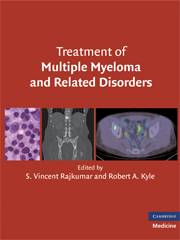Book contents
- Frontmatter
- Contents
- List of Contributors
- 1 DIAGNOSIS AND GENETIC CLASSIFICATION OF MULTIPLE MYELOMA
- 2 STAGING AND RISK-STRATIFICATION OF MULTIPLE MYELOMA
- 3 TREATMENT OF NEWLY DIAGNOSED MULTIPLE MYELOMA
- 4 MAINTENANCE THERAPY IN MULTIPLE MYELOMA
- 5 TREATMENT OF RELAPSED AND RELAPSED/REFRACTORY MULTIPLE MYELOMA
- 6 DIAGNOSIS AND TREATMENT OF MYELOMA BONE DISEASE
- 7 TREATMENT OF MYELOMA-RELATED COMPLICATIONS
- 8 AUTOLOGOUS TRANSPLANTATION FOR MULTIPLE MYELOMA
- 9 ALLOGENEIC STEM CELL TRANSPLANTATION FOR MULTIPLE MYELOMA
- 10 IMMUNOGLOBULIN LIGHT CHAIN AMYLOIDOSIS
- 11 WALDENSTRÖM MACROGLOBULINEMIA/LYMPHOPLASMACYTIC LYMPHOMA
- 12 DIAGNOSIS, RISK-STRATIFICATION, AND MANAGEMENT OF SOLITARY PLASMACYTOMA
- 13 MONOCLONAL GAMMOPATHY OF UNDETERMINED SIGNIFICANCE AND SMOLDERING MULTIPLE MYELOMA
- 14 DIAGNOSIS AND TREATMENT OF POEMS SYNDROME
- Index
- References
4 - MAINTENANCE THERAPY IN MULTIPLE MYELOMA
Published online by Cambridge University Press: 11 July 2009
- Frontmatter
- Contents
- List of Contributors
- 1 DIAGNOSIS AND GENETIC CLASSIFICATION OF MULTIPLE MYELOMA
- 2 STAGING AND RISK-STRATIFICATION OF MULTIPLE MYELOMA
- 3 TREATMENT OF NEWLY DIAGNOSED MULTIPLE MYELOMA
- 4 MAINTENANCE THERAPY IN MULTIPLE MYELOMA
- 5 TREATMENT OF RELAPSED AND RELAPSED/REFRACTORY MULTIPLE MYELOMA
- 6 DIAGNOSIS AND TREATMENT OF MYELOMA BONE DISEASE
- 7 TREATMENT OF MYELOMA-RELATED COMPLICATIONS
- 8 AUTOLOGOUS TRANSPLANTATION FOR MULTIPLE MYELOMA
- 9 ALLOGENEIC STEM CELL TRANSPLANTATION FOR MULTIPLE MYELOMA
- 10 IMMUNOGLOBULIN LIGHT CHAIN AMYLOIDOSIS
- 11 WALDENSTRÖM MACROGLOBULINEMIA/LYMPHOPLASMACYTIC LYMPHOMA
- 12 DIAGNOSIS, RISK-STRATIFICATION, AND MANAGEMENT OF SOLITARY PLASMACYTOMA
- 13 MONOCLONAL GAMMOPATHY OF UNDETERMINED SIGNIFICANCE AND SMOLDERING MULTIPLE MYELOMA
- 14 DIAGNOSIS AND TREATMENT OF POEMS SYNDROME
- Index
- References
Summary
SUMMARY
The role of maintenance therapy in the treatment of patients with multiple myeloma is currently under extensive evaluation. Maintenance therapy is defined as the addition of chronically applied therapy, following induction in responding or stable patient, with the goal of prolonging survival (ASH:FDA Workshop). Prolonged conventional chemotherapy has not only proven to be ineffective as maintenance therapy, but it is also associated with an increased risk of secondary myelodysplastic syndromes. Interferon α and corticosteroids have also been evaluated as maintenance therapy, but these treatments demonstrated marginal benefit at the cost of excessive toxicity. Recent studies have evaluated the role of maintenance thalidomide with hints that for certain subsets there may be a significant benefit. Additional studies are ongoing, testing the combination of thalidomide and corticosteroids, lenalidomide, and bortezomib in the maintenance setting. Future studies will need to identify not only the relative benefit for these agents in the maintenance setting but also the role cytogenetic risk groups play on the relative benefit of maintenance approaches.
INTRODUCTION
Multiple myeloma is an incurable malignancy characterized by the accumulation of malignant plasma cells. Treatment options for patients with myeloma have utilized alkylator-based therapy in conjunction with corticosteroids, and more recently, the widespread use of high-dose therapy and autologous transplant has improved overall survival (OS) for many of these patients. These improvements in OS have been associated with improving the rate of complete remission, a disease state not known to be associated with a cure but with superior long-term outcomes.
- Type
- Chapter
- Information
- Treatment of Multiple Myeloma and Related Disorders , pp. 37 - 45Publisher: Cambridge University PressPrint publication year: 2008



